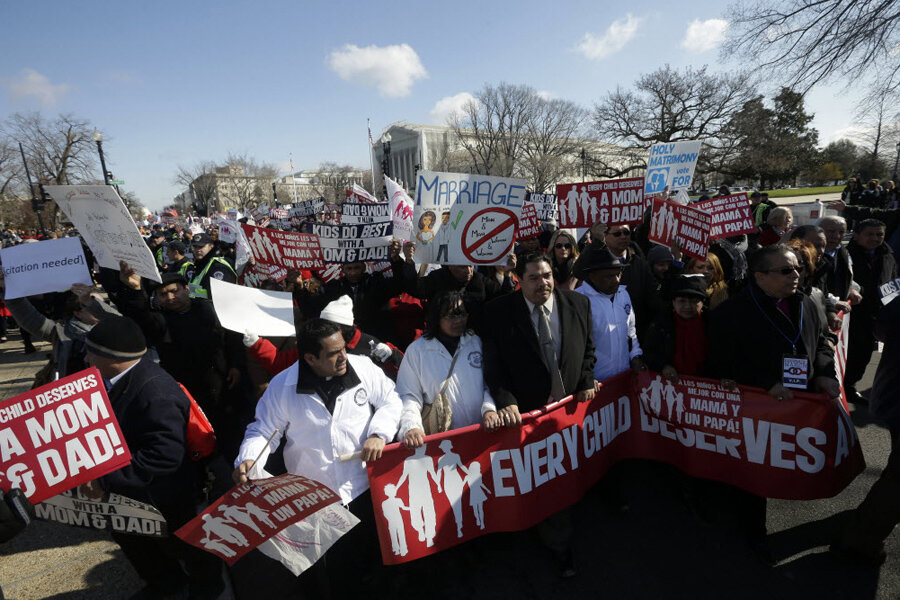Free speech outside Supreme Court: Ban on protests in plaza struck down
Loading...
| Washington
In a case that brings free speech protections literally to the very steps of the US Supreme Court, a federal judge in Washington has struck down as unconstitutional a statute that allowed police to arrest anyone attempting to deliver a message of protest on the wide marble plaza outside the high court’s elegant front entrance.
US District Judge Beryl Howell declared the 60-year-old law in violation of free speech protections and thus void as applied to the court’s plaza.
“The absolute prohibition on expressive activity in the statute is unreasonable, substantially overbroad, and irreconcilable with the First Amendment,” Judge Howell wrote in a 68-page opinion released Tuesday.
The decision puts in doubt a long tradition at the high court of police forcing demonstrators to confine their picketing, chanting, and sign waving to the relatively narrow public sidewalk in front of the court.
The police have consistently enforced the ban against protests on the plaza. During all of the court’s highest profile and most controversial cases – involving abortion, civil rights, affirmative action, the Affordable Care Act, and others – throngs of supporters and opponents routinely jammed the sidewalk on First Street NE in front of the court.
As the crowd swelled, the sea of earnest humanity would spill onto Maryland Avenue to the north and down the sidewalk toward the Library of Congress. But through it all, the protests have never surged forward past the line of police officers to occupy the white-marble plaza with its fountains, benches, and flag pole.
Now, that may change.
The decision comes in the case of a Maryland man, Harold Hodge, who was arrested in January 2011 for standing silently on the marble plaza while wearing a 3-by-2-foot sign around his neck.
The sign read: “The US Gov. Allows Police To Illegally Murder And Brutalize African Americans and Hispanic People.”
A member of the Supreme Court’s police force advised Mr. Hodge, who is African-American, that such protests were not allowed on the plaza. If he wanted to display his sign and make a political point he needed to move to the concrete sidewalk.
Hodge firmly but quietly refused. The officer delivered three warnings. He then placed Hodge in handcuffs and led him to a cell inside the Supreme Court building.
Hodge was charged with violating Section 6135 of the US Code. It reads in full: “It is unlawful to parade, stand, or move in procession or assemblages in the Supreme Court Building or grounds, or to display in the Building and grounds a flag, banner, or device designed or adapted to bring into public notice a party, organization, or movement.”
A federal prosecutor later dropped the charge against Hodge if he agreed to stay away from the Supreme Court for six months.
Hodge avoided the high court, and instead hired a lawyer and filed a lawsuit at the federal courthouse. He said in the suit that he wanted to return to the Supreme Court plaza to engage in peaceful, non-disruptive political speech. He added that the challenged law had a deterrent and chilling effect on his desire to convey his political message.
Supreme Court officials defended the tough statute as a “reasonable limitation on speech” that advanced two significant government interests. It facilitated the unimpeded ingress and egress of visitors to the high court, they said.
Second, the restrictions preserved “the appearance of the Court as a body not swayed by external influence.”
Judge Howell rejected both justifications. The interest in ease of access into and out of the high court does not justify the broad prohibitions on speech, she said.
“The statute encompasses not only a ban on activity that actually impedes ingress and egress,” she wrote, “but also bans a variety of other unobtrusive actions ranging from the assembling of groups of two or more individuals on a bench on one side of the plaza, an individual standing in one place holding a sign of limited size, or the display of political messages on a T-shirt by one individual or a group of individuals all wearing the same T-shirt.”
The judge added: “A broad prohibition of expressive activity of this nature is simply not reasonable.”
She also rejected the suggestion that the ban on protests was necessary to preserve the appearance of a Court not swayed by external influences.
“It is hard to imagine how tourists assembling on the plaza wearing T-shirts bearing their school’s seal, for example, could possibly create the appearance of a judicial system vulnerable to outside pressure,” she wrote.
Judge Howell declined an invitation to impose a more limited reading of the statute or attempt a judicial rewriting of the measure. She said she would leave “any future iterations of this overbroad statute to Congress rather than allow the statute to continue chilling speech.”
Hodge’s lawsuit was undertaken with the assistance of the Rutherford Institute, a non-profit civil rights group based in Charlottesville, Va.
John Whitehead, Rutherford’s president, praised the judge’s decision.
“Judge Howell’s frank, no-holds-barred ruling affirming the Supreme Court plaza as a free speech zone throws a lifeline to the First Amendment at a time when government officials are doing their best to censor, silence, and restrict free speech activities,” Mr. Whitehead said in a statement.







